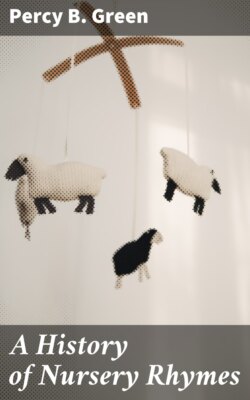Читать книгу A History of Nursery Rhymes - Percy B. Green - Страница 8
На сайте Литреса книга снята с продажи.
CHAPTER III.
ОглавлениеTable of Contents
"The moon is up; by Heaven, a lovely eve!
Long streams of light o'er dancing waves expand."
The Norwegian explorer, Dr. Nansen, in his address to the Royal Geographical Society on February 9th, 1897, stated:—
"The long Arctic day was beautiful in itself, though one soon got tired of it. But when that day vanished and the long Polar night began, then began the kingdom of beauty, then they had the moon sailing through the peculiar silence of night and day. The light of the moon shining when all was marble had a most singular effect."[B]
Writers on Comparative Religions for the most part assert that moon worship amongst the almost utterly savage tribes in Africa and America, the hunting, nomad races of to-day, is a noteworthy feature. "It is not the sun that first attracted the attention of the savage."[C] "In order of birth the worship of the night sky, inclusive of that of the moon, precedes that of the day sky and the sun. It was observed long ago that wherever sun worship existed moon worship was to be found, being a residuum of an earlier state of religion."[D]
What the early primal melody of thousands of years ago may have been one can hardly suggest, but that the subject-matter of the song was mythical there can be very little doubt, and, like folk-lore tales, built upon and around nature worship; for as the capacity for creating language does not exhaust all its force at once, but still continues to form new modes of speech whenever an alteration of circumstances demands them, so it is with myths. The moon during a long Polar night reigning in a kingdom of crystalline beauty, when all around is silence and grandeur, would suggest to the dweller on the fringe of the ice fields—his deity. The sun, in like manner shedding forth its genial warmth, the agriculturist would learn to welcome, and to ascribe to its power the increase of his crop, and just as the limitation of reason holds the untutored man in bondage, so the myth, the outcome of his ignorance, becomes his god.
Even though social advancement has made rapid strides among comparatively modern peoples and nations, not only traces of mythological, but entire religious observances, reclothed in Christian costumes, are still kept up. Praying to an apple tree to yield an abundant crop was the habit of the Bohemian peasant, until Christian teaching influenced him for the better; yet such a hold had the tradition of his ancestors over him that the custom still survives, and yearly on Good Friday before sunrise he enters his garden, and there on his knees says—
"I pray, O green tree, that God may make thee good."
The old form ran thus—
"I pray thee, O green tree, that thou yield abundantly."
In some districts the lash of the Bohemian peasant's whip is well applied to the bark of the tree, reminding one of the terse verse—
"A woman, a spaniel, and walnut tree,
The more you beat them the better they be."
There is also something akin, in this Bohemian's former sentiment, to the wish our nursery children make while eating apples. Coming to the cores they take out the pippins and throw them over the left shoulder, exclaiming—
"Pippin, pippin, fly away;
Bring me an apple another day."
Surely a tree hidden within its fruit.
In the German fairy tale of Ashputtel, also known as the golden slipper—a similar legend is extant amongst the Welsh people—and from which our modern tale of Cinderella and her glass slipper came, a tree figured as the mysterious power. After suffering many disappointments Ashputtel, so the legend relates, goes to a hazel tree and complains that she has no clothes in which to go to the great feast of the king.
"Shake, shake, hazel tree,
Gold and silver over me,"
she exclaims, and her friends the birds weave garments for her while the tree makes her resplendent with jewels of gold and silver.
"Children's sport, popular sayings, absurd customs, may be practically unimportant, but they are not philosophically insignificant, bearing as they do on primitive culture."[E] Trans-Alpine Europe was a greater mystery to the nations on the littoral of the Mediterranean at the time of Christ's appearance in Syria than any spot in Central Africa is to us to-day.
Across the Northern mountain chains were regions unaffected by Greek or Roman culture, and the only light shed on the memorials of Northern Europe's early youth comes from the contributory and dimly illuminative rays of folk-lore.
